The wet weather is back here in Ireland - was too good to last. Ah well, that was our summer - nice while it lasted I suppose :-) Still at least now the garden had a good soaking last night (and its still continuing!).
The warmth and the rain are making it ideal for Blight on both Potatoes and Tomatoes.
Great article on potato blight
http://www.killarneygardencentre.com/potato-blight
Watch out for this ( image from the above site which was credited to Wikipedia) on the leaves of your potato and tomato plants ( as tomatoes are part of the potato family which makes them also susceptible).
On the good news front - Met Eireann ( The Irish Meteorological Service) have produced average temperatures for Ireland over the past 30 years and where I am based is up at the top of the chart!
Source - Irish Average Temp 1981-2010
Was down in Cork Tuesday evening and took a walk in by UCC. Saw these lovely trees hanging over the offshoot of the River Lee and I thought I would share them with you. They aren't great quality as taken from my phone but it was just so peaceful there watching the water go by.
This blog is a track of my fun and games with trying to grow my own vegetables in both beds and raised beds as well as some of my design ideas for my garden. There is a lesson in every failure and food in every success!
Thursday, May 31, 2012
Wednesday, May 30, 2012
Drying seed
Great article I found on drying seed. Haven't tried this yet myself - but think it is definitely on the trial list for this year.
In the past, I have just gathered seed and let it dry naturally on a windowsill and then put it into envelopes for storage which has worked with a reasonably high percentage of seeds germinating the following year.
http://www.realseeds.co.uk/Drying.html
How can we dry the seed at home?
We'll use dry rice to suck the water out of the seed & get it really dry. Then it will hibernate completely.
You need to get:
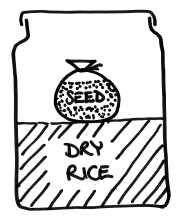 Bake
the rice on a tray in the oven for 45 minutes until it is bone dry.
While it is still hot, put it in the jam-jar , about half full, and
screw the lid on .
Bake
the rice on a tray in the oven for 45 minutes until it is bone dry.
While it is still hot, put it in the jam-jar , about half full, and
screw the lid on .
Wait patiently until the rice is cool. (If you rush this you'll cook your seeds.) So you now have a jam jar 1/2 full of very dry, cool rice.
Put your seed in a bag made by cutting off the foot of the tights, and tie it in with a rubber band. Put it in with the cool dry rice. Put the lid on tightly, so damp air can't get in.
Leave your seed sealed in the jar with the dry rice for a fortnight, and the dampness in the seed will be drawn out into the rice.
You now have bone-dry seed that you can safely seal in a plastic bag, and it will keep for several years.
In the past, I have just gathered seed and let it dry naturally on a windowsill and then put it into envelopes for storage which has worked with a reasonably high percentage of seeds germinating the following year.
http://www.realseeds.co.uk/Drying.html
Home Seed Drying & Storage
This is a really important bit. You need to dry your seed out, or it will not keep.
Seed that is air-dry is not really properly dormant - its just napping;
so it is still burning through its stored reserves of energy and will soon run flat - like a mobile phone left on.
Also, you can't put it in a sealed container as it is still
breathing - it would suffocate. And without a sealed container, it will
soon reabsorb water from the air on the first humid day, and start
getting ready to germinate. Seed that is air-dry is not really properly dormant - its just napping;
so it is still burning through its stored reserves of energy and will soon run flat - like a mobile phone left on.
How can we dry the seed at home?
We'll use dry rice to suck the water out of the seed & get it really dry. Then it will hibernate completely.
You need to get:
- a big jam-jar with a good lid,
- an old pair of tights,
- a rubber band,
- and some rice
 Bake
the rice on a tray in the oven for 45 minutes until it is bone dry.
While it is still hot, put it in the jam-jar , about half full, and
screw the lid on .
Bake
the rice on a tray in the oven for 45 minutes until it is bone dry.
While it is still hot, put it in the jam-jar , about half full, and
screw the lid on . Wait patiently until the rice is cool. (If you rush this you'll cook your seeds.) So you now have a jam jar 1/2 full of very dry, cool rice.
Put your seed in a bag made by cutting off the foot of the tights, and tie it in with a rubber band. Put it in with the cool dry rice. Put the lid on tightly, so damp air can't get in.
Leave your seed sealed in the jar with the dry rice for a fortnight, and the dampness in the seed will be drawn out into the rice.
You now have bone-dry seed that you can safely seal in a plastic bag, and it will keep for several years.
Tuesday, May 29, 2012
Plant hardiness zones
A lot of websites (especially American ones) will talk about plants suitable for certain zones - to find out what zone you are in there is some help below. I always found it slightly confusing until I checked the details below.
One thing to note - that the Irish winters were harsher than is described below - to ensure your plants survival, you can go with plants suitable for slightly harsher winters (i.e. Zone 7 or 8 plants).
What are plant hardiness zones and why are they important?
Well, plant hardiness zones are a guide to help you know which plants will grow and survive where you live.
A hardiness zone is a geographically-defined zone in which a specific category of plant life is capable of growing, as defined by temperature hardiness, or ability to withstand the minimum temperatures of the zone.
The plant hardiness zone maps below will show you if certain plants can manage your areas temperatures.
Plants vary in the temperature extremes they can endure, the lower temperature especially being an important factor.
Due to the moderating effect of the Gulf Stream on the Irish and UK's temperate maritime climate, the UK, and Ireland even more so, have rather milder winters than their northerly position suggests.
This means that the hardiness zones relevant to the Ireland are quite high, from 8 to 10, as shown below.
* 7. Central Scotland and the Highlands, and locally in the Southern Uplands and the Pennines.
* 8. Parts of central Ireland and Most of England, Wales and Scotland.
* 9. Most of coastal Ireland, western and southern England and Wales, western Scotland, also a very narrow coastal fringe on the east coast of Scotland and northeast England (within 5 km of the North Sea).
* 10. Very low lying coastal areas of the southwest of Ireland, and the Isles of Sicilly.
Plant hardiness map for Ireland and UK................Plant hardiness map for Europe
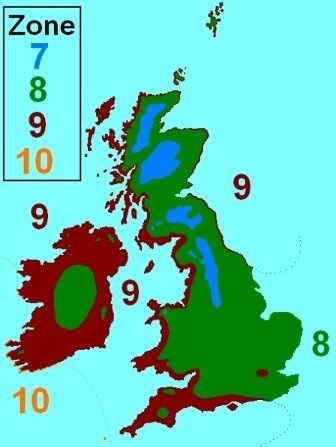
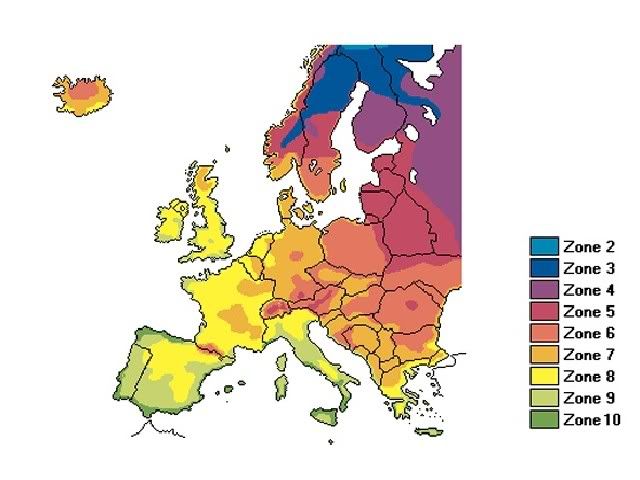
Zone 2: -46 to -40 C (-50 to -40 F)
Zone 3: -40 to -34 C (-40 to -30 F)
Zone 4: -34 to -29 C (-30 to -20 F)
Zone 5: -29 to -23 C (-20 to -10 F)Zone 6: -23 to -18 C (-10 to 0 F)
Zone 7: -18 to -12 C (0 to 10 F)
Zone 8: -12 to -7 C (10 to 20 F)
Zone 9: -7 to -1 C (20 to 30 F)
Zone 10: -1 to 4 C (30 to 40 F)
Zone 11: above 4 C (above 40 F)
So, looking at the map we can see that the south coast of Ireland is a zone 9 and has a lowest possible temperature of -7 to -1 C (20 to 30 F).
It has a higher base temperature than the north with a zone 8 rating of -12 to -7 C (10 to 20 F)
If we had a severe frost across Ireland, frost susceptible plants in the south may have a better chance of survival then similar plants in the midlands of Ireland.
Many plant books and labels state the zone hardiness for plants, it will serve you well to heed them.
Definitions of Frosts and the possible damage caused.
0° Celsius is a commonly called a touch of frost.
The damage to your plants should be slight, however, it depends upon the duration of the frost, topography of the growing area etc.
-2° C to 0° Celsius is a light Freeze
Your very tender plants may be killed with little effect on other hardier vegetation.
-4° C to -2° Celsius is a Moderate Freeze
Many plants in your garden will be damaged especially fruit blossoms and tender plants.
sustained -5 ° Celsius and colder is regarded as quite a Severe Freeze here in Ireland.
Below this temp you will experience damage to all but the hardiest of your plants.
New Zealand has very similar plant hardiness zone zones to Ireland.
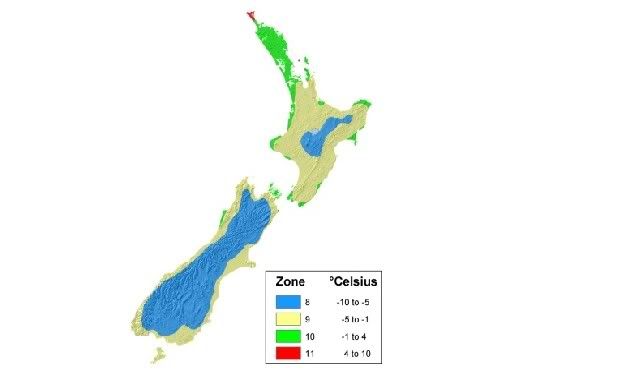
Lots of plants native to New Zealand thrive in Ireland.
Here is the plant hardiness zone map for Australia, as well
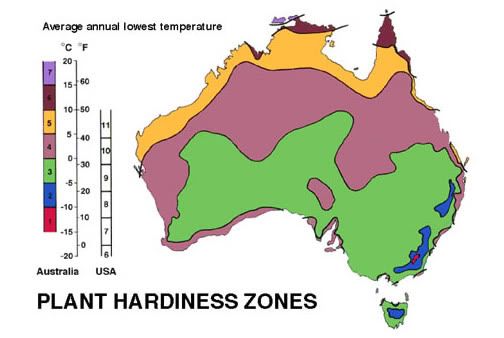
For some extremes of temperature, here is the US, Canada and Mexico plant hardiness zone map.
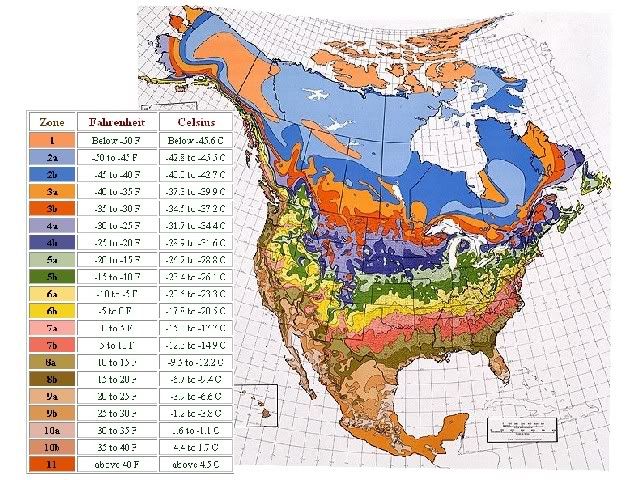
Here is the USA map on its own.

Information referenced from http://www.gardenplansireland.com/forum/about132.html
One thing to note - that the Irish winters were harsher than is described below - to ensure your plants survival, you can go with plants suitable for slightly harsher winters (i.e. Zone 7 or 8 plants).
What are plant hardiness zones and why are they important?
Well, plant hardiness zones are a guide to help you know which plants will grow and survive where you live.
A hardiness zone is a geographically-defined zone in which a specific category of plant life is capable of growing, as defined by temperature hardiness, or ability to withstand the minimum temperatures of the zone.
The plant hardiness zone maps below will show you if certain plants can manage your areas temperatures.
Plants vary in the temperature extremes they can endure, the lower temperature especially being an important factor.
Due to the moderating effect of the Gulf Stream on the Irish and UK's temperate maritime climate, the UK, and Ireland even more so, have rather milder winters than their northerly position suggests.
This means that the hardiness zones relevant to the Ireland are quite high, from 8 to 10, as shown below.
* 7. Central Scotland and the Highlands, and locally in the Southern Uplands and the Pennines.
* 8. Parts of central Ireland and Most of England, Wales and Scotland.
* 9. Most of coastal Ireland, western and southern England and Wales, western Scotland, also a very narrow coastal fringe on the east coast of Scotland and northeast England (within 5 km of the North Sea).
* 10. Very low lying coastal areas of the southwest of Ireland, and the Isles of Sicilly.
Plant hardiness map for Ireland and UK................Plant hardiness map for Europe


Zone 2: -46 to -40 C (-50 to -40 F)
Zone 3: -40 to -34 C (-40 to -30 F)
Zone 4: -34 to -29 C (-30 to -20 F)
Zone 5: -29 to -23 C (-20 to -10 F)Zone 6: -23 to -18 C (-10 to 0 F)
Zone 7: -18 to -12 C (0 to 10 F)
Zone 8: -12 to -7 C (10 to 20 F)
Zone 9: -7 to -1 C (20 to 30 F)
Zone 10: -1 to 4 C (30 to 40 F)
Zone 11: above 4 C (above 40 F)
So, looking at the map we can see that the south coast of Ireland is a zone 9 and has a lowest possible temperature of -7 to -1 C (20 to 30 F).
It has a higher base temperature than the north with a zone 8 rating of -12 to -7 C (10 to 20 F)
If we had a severe frost across Ireland, frost susceptible plants in the south may have a better chance of survival then similar plants in the midlands of Ireland.
Many plant books and labels state the zone hardiness for plants, it will serve you well to heed them.
Definitions of Frosts and the possible damage caused.
0° Celsius is a commonly called a touch of frost.
The damage to your plants should be slight, however, it depends upon the duration of the frost, topography of the growing area etc.
-2° C to 0° Celsius is a light Freeze
Your very tender plants may be killed with little effect on other hardier vegetation.
-4° C to -2° Celsius is a Moderate Freeze
Many plants in your garden will be damaged especially fruit blossoms and tender plants.
sustained -5 ° Celsius and colder is regarded as quite a Severe Freeze here in Ireland.
Below this temp you will experience damage to all but the hardiest of your plants.
New Zealand has very similar plant hardiness zone zones to Ireland.

Lots of plants native to New Zealand thrive in Ireland.
Here is the plant hardiness zone map for Australia, as well

For some extremes of temperature, here is the US, Canada and Mexico plant hardiness zone map.

Here is the USA map on its own.

Information referenced from http://www.gardenplansireland.com/forum/about132.html
Monday, May 28, 2012
Fab weather
The weather in Ireland over the past few days has just been fabulous!! Plants have been thriving in the extra warmth - gone from frost by night the week before to temps in the mid to high 20's C.
The potatoes in the purple bed are so healthy looking - doing great so far. Really hopeful of a good crop from these if they stay this healthy!
I will have a large amount ready at the same time, but planning on blanching and freezing them for a supply through the next few months. Just pick - into boiling water for 2-3mins, cool, dry and then onto a freezer tray for a few hours and then bag them up and most importantly label them with date picked. You can just put them into a bag to freeze after blanching, but they will all freeze together and make it very hard to use them.
The potatoes in the purple bed are so healthy looking - doing great so far. Really hopeful of a good crop from these if they stay this healthy!
The Calebrese ( broccoli to you and me) has started showing its first signs of the flowers forming ( which of course is actually the part we eat). I will have to monitor these closely over the next few weeks as it can go very quickly from ready to pick to flowering and too far gone.
 |
Spring onions (in groups) planted out. There were about 8 seeds put into each plug tray and now planted out between 2 wide rows of garlic into the red bed. |
Finally got started with getting some of the bark down. Over 20 bags later, time was called and off to enjoy the sunshine. Plenty of days in the week to be putting down bark - but it might just have been our summer!
Jobs to do this week:
Hoeing - bit behind on this - though did spend over an hour hoeing and rocking picking at my peas last weekend.
More scallion and herb seeds to sow
Get my purple sprouting broccoli started for next spring
Also saved some cyclamen seeds from the plants through last winter and going to try sowing them now for autumn - don't know if the seeds will be viable or not - only one way to find out I reckon :-) If anyone has any tips - feel free to let me know!
http://en.wikipedia.org/wiki/Cyclamen
Rock picking - so many rocks/stones in the soil here. Using all that I collect as mini paths/edges around my raised beds. Buckets and buckets have been picked so far.
Ok - as I look at that list, I better go out and get started and leave the updating :-)))
Friday, May 25, 2012
Glorious sunshine
What fabulous weather we are having now this week in Ireland. Yesterday was just a joy to be out in the garden. I love this time where first harvests are starting to take place and you can see the rest of the plants starting to grow - makes all the time bringing them on worthwhile!
Planted out my bush tomatoes into the bed with the strawberries and salad leaves - will be interesting to see how it does with the irish summer. I have 2 other bush tomato plants kept in the greenhouse to see how they do in comparison.
Some plums on the tree - first harvest - tree was planted last year. Very exciting!! I love plums straight from the tree - I grew up with one in an orchard behind my house and spent many a summer covered in hives from eating as much as I could (before the birds and bees got to them!).
Blossoms on the apple trees as well - I can see the buds on the cooking apple trees, so hopefully these will follow shortly.
The spuds (potatoes) in the raised bed are doing so much better than the spuds in the pot, but that would be expected. The ones in the ground have finally shown their heads above soil and look good so far - these will have to be monitored closely for blight as those planted later are at a higher risk according to all my research.
My tomatoes in the greenhouse - there is a bush tomato plant in the pot over the roses tin. Rest are growing nicely and started to produce flowers now so time to get feeding. It is recommended to start feeding (every second watering) once the flower buds have set.
Salad leaves - picked a few of these shortly after the photo was taken for part of my salad last night. So fresh and tangy!
Loads of yummy strawberries growing - only 2 didn't like the move from previous place to the raised bed, but they weren't the strongest plants either.
My brassica bed is just magnificent at the moment. Everything looking so healthy - brocoli on the right and brussels sprouts and cauliflower from the left.
Parsnips are growing well - those planted almost a month later have caught up with the early planted ones - definitely not worth planting out too early - one lesson learned.
The first radishes were picked yesterday - Jolly variety. These were added to the salad last night - lovely fresh crunch and peppery taste from them.
Beetroot growing well.
Planted the carrots from the toilet roll holders out into the garden yesterday. I did find some small stones when digging them in, so there would have been a risk of them forking if I had planted them direct.
The carrots below are the ones sown out - the ones in the closest row were planted about the same time as the ones in the toilet rolls and look healthier. The proof will be in the harvesting/eating as they say!
Monday, May 21, 2012
Horseradish
Interesting veg this - its actually a member of the Brassica family. I have never grown this before but bought it in a pot from a nursery. I was advised to keep it in a pot as it can run riot and can be extremely invasive(there are mixed views on this around the web - some say it can be happily companion planted with potatoes, some say it will take over).
I have been advised that a new plant can grow from even a small bit of root so beware when picking!
Info and history
http://en.wikipedia.org/wiki/Horseradish
The advice I have been given on harvesting is that you dig up the whole plant when its dormant in late autumn/winter and then use the large main root for cooking and use the largest of the offshoots as roots for next year. The root will survive for a few weeks in a sealed containter in your fridge until you want to use it.
Horseradish is also reported to have diuretic and digestive uses and be a natural antibiotic.
I look forward to trying out a couple of recipes later this year which I plan on sharing (assuming all goes well) - feel free to let me know if you have any good ones!
Nutritional infomation:
http://nutritiondata.self.com/facts/spices-and-herbs/223/2
I have been advised that a new plant can grow from even a small bit of root so beware when picking!
Info and history
http://en.wikipedia.org/wiki/Horseradish
The advice I have been given on harvesting is that you dig up the whole plant when its dormant in late autumn/winter and then use the large main root for cooking and use the largest of the offshoots as roots for next year. The root will survive for a few weeks in a sealed containter in your fridge until you want to use it.
Horseradish is also reported to have diuretic and digestive uses and be a natural antibiotic.
I look forward to trying out a couple of recipes later this year which I plan on sharing (assuming all goes well) - feel free to let me know if you have any good ones!
Nutritional infomation:
http://nutritiondata.self.com/facts/spices-and-herbs/223/2
Coriander
Coriander is a wonderful herb mainly used in Asian and Indian dishes ( that I am aware of). There are also a lot of old herbal remedies that use the Coriander herb. For more info have a look at the link below.
http://en.wikipedia.org/wiki/Coriander
To keep a ready supply of Coriander, it is best to make succession sowings every few weeks. For instance at the moment, I have some seeds just planted and in the hot press to germinate. I also have seeds that have germinated about two weeks.
And some ready for use. I plan to keep this up over the summer to have a ready supply of Coriander.
Coriander Chilli Chicken Noodle
One of the simplest ways we sometimes use coriander is for a quick late night snack or quick bite to eat - takes all of 5 mins. For this we use chicken flavoured noodles (i.e. Maggi noodles), up to you if you prefer other varieties - chop half a chilli and add to the boiling water with the noodles and the chicken flavoured sachet. While thats cooking - cut and chop a couple of sprigs of Coriander - strain noodles and chilli, add Coriander and you suddenly have a lovely tasting quick snack with a taste of the Orient for only a few cents. Not necessarily the healthiest snack, but definitely a very flavoursome one.
Seeds
The seed from the Coriander plant can also be used in recipes and stored easily for the winter months or can be stored as your seeds for next year. It is best to plan to save seed from early summer sowings, to allow plenty of time for the seed to mature and dry on the plant. Harvest as soon as the seed is brown and dry, as it does tend to drop from the seed heads. Rub the heads together in your hands over a bucket to free the seed.
Nutritional values:
http://www.nutrition-and-you.com/cilantro.html
If these are true - its a pretty amazing plant!!
http://en.wikipedia.org/wiki/Coriander
To keep a ready supply of Coriander, it is best to make succession sowings every few weeks. For instance at the moment, I have some seeds just planted and in the hot press to germinate. I also have seeds that have germinated about two weeks.
And some ready for use. I plan to keep this up over the summer to have a ready supply of Coriander.
Coriander Chilli Chicken Noodle
One of the simplest ways we sometimes use coriander is for a quick late night snack or quick bite to eat - takes all of 5 mins. For this we use chicken flavoured noodles (i.e. Maggi noodles), up to you if you prefer other varieties - chop half a chilli and add to the boiling water with the noodles and the chicken flavoured sachet. While thats cooking - cut and chop a couple of sprigs of Coriander - strain noodles and chilli, add Coriander and you suddenly have a lovely tasting quick snack with a taste of the Orient for only a few cents. Not necessarily the healthiest snack, but definitely a very flavoursome one.
Seeds
The seed from the Coriander plant can also be used in recipes and stored easily for the winter months or can be stored as your seeds for next year. It is best to plan to save seed from early summer sowings, to allow plenty of time for the seed to mature and dry on the plant. Harvest as soon as the seed is brown and dry, as it does tend to drop from the seed heads. Rub the heads together in your hands over a bucket to free the seed.
Nutritional values:
http://www.nutrition-and-you.com/cilantro.html
If these are true - its a pretty amazing plant!!
Friday, May 18, 2012
Herbs
I love to use fresh herbs in my cooking - it can really lift even the most basic of dishes. Here are some of the ones I have growing and some hints on where to use them. Hopefully as the season goes on I will upload some recipes and other uses of some of these.
One of the most useful herbs in the garden. You can use Thyme with roasts, in stews, on pizza, tomato based dishes, soups, gravy etc. I just love thyme. These are new plants down this year - my previous thyme plants lasted 2 years including the hard frost, but died this winter - not really sure of the cause, but our golden retriever puppy did have a liking for that bed!!
2 different varieties of Thyme
Bay Tree (laurel)
The bay leaf is used in soups and stews for flavourings ( and a couple of times a year in mulled wine!!). The tree can grow quiet big so needs to be monitored and will need some hard pruning as it gets older, but you can shape it lovely.
Parsley
I can't believe the Parsley is growing back again this year - this will be my third year from the same parsley plant. Previously I only had it planted in pots and it had to be replaced every year. I reckon the good covering of bark is helping it survive the worst of the weather. Parsley is great as a topping on a dish and can add a kick to salads when you mix it in with the lettuce.
Rosemary
One of my favourite herbs - I love it cooked in roasts - the flavouring it gives as the roast is cooking just has to be smelt to be believed. Again another plant that can grow quiet big, but pruning just means more stems to share or dry.
Purple sage
This has gone wild in the bed - half thinking of moving it to a larger bed, but I fear I have left it too late in the season. Sage is mainly used in a sage and onion stuffing, but there are other uses - I need to discover more of them!
The main herb bed - sage dominating - needs pruning/moving
Chives
Chives are a great plant - they die off in winter but come back every spring. They are a member of the onion family and you can even eat the flowers. They are best sown (I have found) in a wet enough portion of the garden - they don't like to dry out too much. You can start using from early spring till first frosts when it dies off. During winter you can lift the clump and divide making more plants. Lovely in sambos, salads, omlettes - in fact works great with egg in anything.
Thursday, May 17, 2012
Orange bed
This is the 5th and final raised bed which we have this year. I had originally decided to have peas and possibly beans in, however I changed my mind as I reckoned as the bed is already nearly 2ft high that this would be too high for easy cultivation of the peas and beans.
This bed has now been removed from the rotation policy. Currently growing some lettuce, rocket and I have about 20 strawberry plants growing there also. When the weather warms up, I plan to plant a couple of bush tomato plants and hope grow some basil outdoors under a small cloche.
Again here I am planting the lettuce a few weeks apart for a continuous supply.
These are the bush tomatoes that I have growing on a south facing window sill. Some I am going to plant into pots for my small greenhouse and some are going to go directly out into the orange bed ( hedging my bets by having some in the greenhouse). All trial and error at this stage. As the weather is continuing to be very cold at night, it will be at least another couple of weeks before I can risk putting these out.
I also have strawberry's growing in a pot called a strawberry pot - for the past few years, I have been growing summer bedding in this pot, but this year I decided to put it to the use it was made for. Looking forward to eating them - loads of flowers so far! Nothing more delicious that strawberries straight from the plant. I put some water retaining gel into the compost when planting this up to help the plants survive small amounts of drought as terracotta pots can dry out very fast in the sun(as they allow vapour out the container sides and bottom). Glazed or plastic pots won't dry out as fast - interesting article here about the Terracotta v Plastic pot debate.
Choosing a Clay or a Plastic Pot
Wednesday, May 16, 2012
Purple bed
The purple bed is the most boring of the beds in my rotation, but also the one that I am probably guaranteed the best crop. It is my potato bed - the picture below shows the potatoes after their first earthing up. There will also be a second earthing up as the plants grow bigger.
I have seen small amounts of frost damage on a couple of the plants ( a blackening of some of the leaves), however this shouldn't impede them too much as its only minimal damage.
This is my first time planting potatoes in a raised bed, so I am interested to see what the yield will be like compared to the ones grown directly in the soil.
Though this year, my owns in the soil were very late going down - it was late April before they were planted whereas I would have preferred to get them down mid-March - the tradition being to have them planted by St. Patricks day. But we had a lot of other landscaping and moving of soil before the bed could be prepared.
I have a lot of rock picking to do in this bed - will potter along with it as the months go on - will probably not get it all complete this year - but hopefully by next year it will be in good condition.
I have also tried going 3 potato tubers in this pot - nearly ready for its first earthing up. I just want to see how they do and what yield we can get from potatoes even in a pot. Though the pot doesn't look very large here, its probably about 24inches wide at the top and about the same in height. Not sure if its big enough for 3 tubers, but again its only a little side experiment.
I have seen small amounts of frost damage on a couple of the plants ( a blackening of some of the leaves), however this shouldn't impede them too much as its only minimal damage.
This is my first time planting potatoes in a raised bed, so I am interested to see what the yield will be like compared to the ones grown directly in the soil.
Though this year, my owns in the soil were very late going down - it was late April before they were planted whereas I would have preferred to get them down mid-March - the tradition being to have them planted by St. Patricks day. But we had a lot of other landscaping and moving of soil before the bed could be prepared.
I have a lot of rock picking to do in this bed - will potter along with it as the months go on - will probably not get it all complete this year - but hopefully by next year it will be in good condition.
Subscribe to:
Posts (Atom)








































